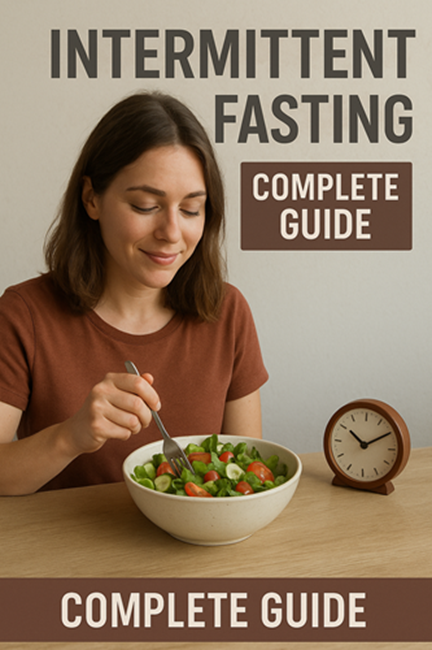In a world full of fad diets and trendy eating plans, intermittent fasting (IF) has stood the test of time. But if you’re new to it, you might be wondering: Is intermittent fasting right for me? Will I be starving all day? How does it actually help with weight loss or health?
This comprehensive beginner’s guide will walk you through everything you need to know about intermittent fasting in 2025 – from types and benefits to mistakes to avoid and meal planning strategies.

What Is Intermittent Fasting?
Intermittent fasting is not a diet. It’s an eating pattern that cycles between periods of eating and fasting. It doesn’t focus on what you eat, but when you eat.
Think of it as scheduled eating – a way to allow your body to reset, reduce insulin levels, and burn stored fat more efficiently.
How Intermittent Fasting Works
When you eat, your body uses the food for energy. After several hours without food, insulin levels drop and your body begins to burn stored fat for fuel.
By restricting the eating window:
- Your insulin sensitivity improves
- You consume fewer calories naturally
- Your body enters a state called ketosis, which aids in fat burning
Benefits of Intermittent Fasting
Weight loss without counting calories
Improved insulin sensitivity and reduced risk of Type 2 diabetes
Cell repair and autophagy (removal of waste from cells)
Better mental clarity and focus
Reduced inflammation
Potential increase in lifespan (animal studies show promising results)
6 Popular Types of Intermittent Fasting
1. 16:8 Method (Lean gains)
- Fast for 16 hours, eat within an 8-hour window.
- Most popular among beginners.
- Example: Eat from 12 PM to 8 PM, fast from 8 PM to 12 PM next day.
2. 14:10 Method
- A gentler version of 16:8.
- Good starting point for beginners or women.
3. 5:2 Method
- Eat normally 5 days a week, restrict to 500–600 calories on 2 non-consecutive days.
4. Alternate Day Fasting (ADF)
- Fast every other day (caloric intake <500 kcal on fasting days).
- Not recommended for beginners.
5. OMAD (One Meal A Day)
- 23 hours fasting, 1 big meal daily.
- Advanced method, often used for plateau-breaking.
6. Warrior Diet
- 20 hours fasting, 4-hour eating window in the evening.
Who Should Not Try Intermittent Fasting
- History of eating disorders
- Pregnant or breastfeeding women
- Children or teens under 18
- Underweight individuals
- Those on blood sugar medications or insulin (consult a doctor first)
How to Start Intermittent Fasting as a Beginner
Step 1: Choose a Fasting Method
Most beginners start with 16:8 or 14:10. Pick what suits your lifestyle.
Step 2: Start Slowly
Don’t jump into 16-hour fasts. Ease your body in:
- Week 1: 12:12
- Week 2: 14:10
- Week 3: 16:8
Step 3: Focus on Nutrient-Dense Meals
During your eating window, eat whole foods:
- Protein (chicken, tofu, eggs)
- Complex carbs (quinoa, brown rice)
- Healthy fats (avocado, nuts, olive oil)
- Fiber-rich veggies and fruits
Step 4: Stay Hydrated
Drink plenty of water, herbal teas, black coffee (no cream or sugar) during fasting.
Step 5: Avoid Breaking Your Fast with Junk
Avoid:
- Sugary snacks
- Fried food
- White carbs
- Alcohol
What Can You Consume While Fasting?
Allowed:
- Water (plain or infused)
- Black coffee
- Black/green/herbal tea
- Apple cider vinegar (diluted)
Not Allowed:
- Milk
- Juice
- Soft drinks
- Anything with calories
Sample 16:8 Intermittent Fasting Schedule
| Time | Activity |
|---|---|
| 8:00 AM | Black coffee or water |
| 10:00 AM | Herbal tea or lemon water |
| 12:00 PM | First meal (protein + carbs + veg) |
| 4:00 PM | Light snack (nuts, yogurt, smoothie) |
| 7:30 PM | Dinner (light, protein-rich) |
| 8:00 PM | Start fast until next day |
Common Mistakes to Avoid
❌ Overeating during eating window
❌ Not drinking enough water
❌ Skipping electrolytes (especially sodium, potassium)
❌ Fasting too aggressively in the beginning
❌ Thinking intermittent fasting is a “magic bullet”
Tips to Make Fasting Easier
🔹 Sleep well – Poor sleep can increase hunger hormones
🔹 Stay busy – Distract yourself during fasting window
🔹 Have black coffee – It suppresses appetite for some people
🔹 Use apps – Try Zero, Fastient, or MyFast to track fasting hours
🔹 Be consistent – Results appear after 2–4 weeks
Realistic Results Timeline
| Week | What to Expect |
|---|---|
| 1 | Hunger and fatigue, slight mood swings |
| 2 | Improved focus, reduced cravings |
| 3–4 | Weight loss begins, energy stabilizes |
| 5+ | Increased fat burning, better metabolic health |
Intermittent Fasting for Women – Special Considerations
Women may be more sensitive to fasting. Tips for women:
- Start with 12:12 or 14:10
- Avoid fasting during menstruation if it causes fatigue
- Watch for hormonal imbalances – irregular periods or extreme fatigue may mean you’re fasting too long
Intermittent Fasting Myths Busted
Myth 1: You’ll lose muscle
Truth: You maintain muscle if you eat enough protein and do resistance training.
Myth 2: You can eat anything during your eating window
Truth: Junk food cancels the benefits. Clean eating is key.
Myth 3: Fasting slows down your metabolism
Truth: Short-term fasting may actually boost metabolism slightly.
Frequently Asked Questions (FAQ)
Q: Can I work out while fasting?
Yes, light to moderate workouts like walking, yoga, and even strength training are fine.
Q: Will I feel hungry all the time?
Initially, yes. But your body adapts quickly. Hunger will reduce after 3–5 days.
Q: How much weight can I lose?
Depends on your current body weight, eating habits, and consistency. Most people lose 0.5–1 kg/week.
Q: Is it safe long-term?
Yes, many people follow intermittent fasting as a lifestyle for years. Just ensure balanced nutrition.
Final Thoughts
Intermittent fasting is a powerful lifestyle strategy that’s simple, flexible, and free. It can help you lose weight, feel better, and even live longer — without obsessing over calories. But like any change, it takes time, discipline, and personalization.
Start slow, listen to your body, and focus on sustainability, not perfection.
Get more Health and Lifestyle Updates With Popnewsblend.

Hi, I’m Prashant Jain — a curious soul, storyteller, and content creator at heart.I’ve always been drawn to the world of entertainment, travel, sports, health & lifestyle — not just as a writer, but as someone who genuinely lives these experiences. Whether I’m binge-watching the latest OTT series, exploring offbeat spiritual destinations in India, or diving deep into wellness routines and cricket match insights, I love sharing what I discover with like-minded readers.
PopNewsBlend is my way of blending personal journeys with meaningful stories — ones that inform, inspire, and keep you ahead of the curve. Everything I write comes from real observations, hands-on experiences, and a deep passion for understanding the world around us.
Discover more from Popnewsblend
Subscribe to get the latest posts sent to your email.








Pingback: Fasting: Benefits, Religious Significance, and the Indian Connection